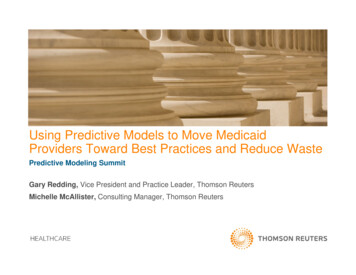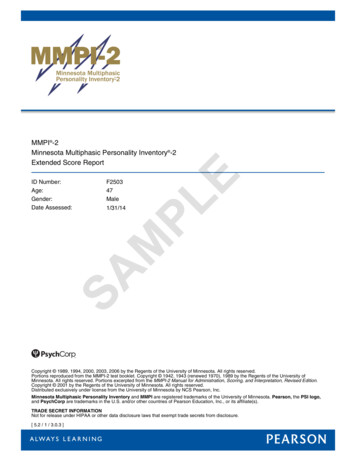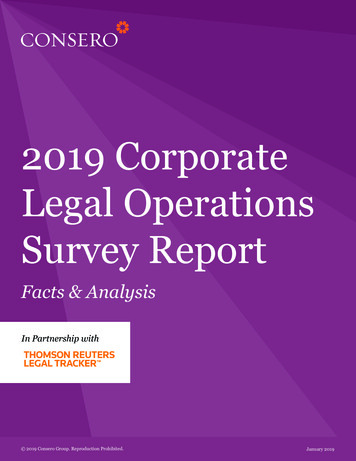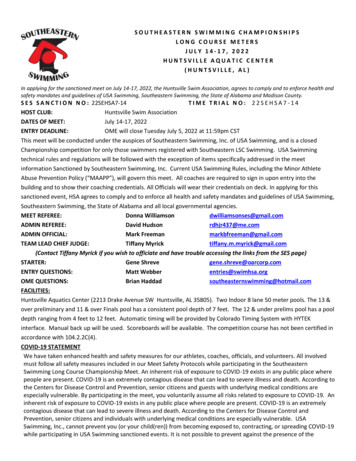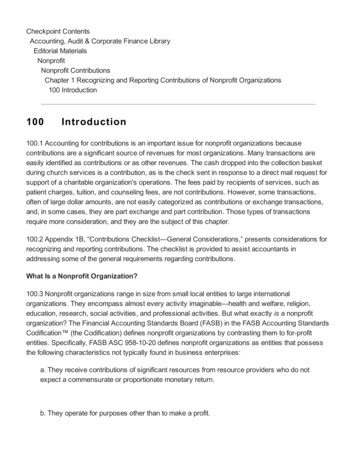
Transcription
Checkpoint ContentsAccounting, Audit & Corporate Finance LibraryEditorial MaterialsNonprofitNonprofit ContributionsChapter 1 Recognizing and Reporting Contributions of Nonprofit Organizations100 Introduction100Introduction100.1 Accounting for contributions is an important issue for nonprofit organizations becausecontributions are a significant source of revenues for most organizations. Many transactions areeasily identified as contributions or as other revenues. The cash dropped into the collection basketduring church services is a contribution, as is the check sent in response to a direct mail request forsupport of a charitable organization's operations. The fees paid by recipients of services, such aspatient charges, tuition, and counseling fees, are not contributions. However, some transactions,often of large dollar amounts, are not easily categorized as contributions or exchange transactions,and, in some cases, they are part exchange and part contribution. Those types of transactionsrequire more consideration, and they are the subject of this chapter.100.2 Appendix 1B, “Contributions Checklist—General Considerations,” presents considerations forrecognizing and reporting contributions. The checklist is provided to assist accountants inaddressing some of the general requirements regarding contributions.What Is a Nonprofit Organization?100.3 Nonprofit organizations range in size from small local entities to large internationalorganizations. They encompass almost every activity imaginable—health and welfare, religion,education, research, social activities, and professional activities. But what exactly is a nonprofitorganization? The Financial Accounting Standards Board (FASB) in the FASB Accounting StandardsCodification (the Codification) defines nonprofit organizations by contrasting them to for profitentities. Specifically, FASB ASC 958 10 20 defines nonprofit organizations as entities that possessthe following characteristics not typically found in business enterprises:a. They receive contributions of significant resources from resource providers who do notexpect a commensurate or proportionate monetary return.b. They operate for purposes other than to make a profit.
c. There is an absence of ownership interests like those of business enterprises.100.4 In some cases, it may be difficult to determine whether an entity is a nonprofit organizationsince nonprofit organizations may have the preceding characteristics in varying degrees. (Forexample, an organization may receive significant revenue from exchange transactions rather thancontributions but still meet the nonprofit definition.) In other cases, it is fairly obvious that an entitydoes not have the characteristics of a nonprofit organization. The glossary definition of “not for profitentity” in FASB ASC 958 10 20 notes that nonprofit organizations do not include “investor ownedentities and entities that provide dividends, lower costs, or other economic benefits directly andproportionately to their owners, members, or participants, such as mutual insurance entities, creditunions, farm and rural electric cooperatives, and employee benefit plans.”100.5 To help clarify what a nonprofit organization is for purposes of generally accepted accountingprinciples (GAAP), FASB ASC 958 10 15 notes that nonprofit entities include the types oforganizations listed in Exhibit 1 1.Exhibit 1 1Types of Nonprofit OrganizationsCemetery organizationsCivic and community organizationsColleges and universitiesElementary and secondary schoolsFederated fund raising organizationsFraternal organizationsHealth care entitiesLabor unionsLibrariesMuseumsOther cultural organizationsPolitical partiesPolitical action committeesPrivate and community foundationsProfessional associationsPublic broadcasting stationsReligious organizationsResearch and scientific organizationsSocial and country clubsTrade associationsVoluntary health and welfareorganizationsZoological and botanical societies
Performing arts organizationsWhich Nonprofit Organizations Should Use This Guide?100.6 The accounting principles discussed in PPC's Guide to Nonprofit Contributions apply to allnongovernmental nonprofit organizations except providers of health care services covered by theAICPA Audit and Accounting Guide, Health Care Entities. Thus, this Guide does not apply to entitiesthat are required to issue financial reports in accordance with guidance promulgated by theGovernmental Accounting Standards Board or the Federal Accounting Standards Advisory Board.Governmental organizations include public corporations and organizations that have one or more ofthe following characteristics:a. Popular election of officers or appointment (or approval) of a controlling majority of themembers of the organization's governing board by officials of one or more state or localgovernments.b. The potential for unilateral dissolution of the organization by a government with the net assetsreverting to a government.c. The power to enact and enforce a tax levy.Organizations that can issue tax exempt debt directly are also presumed to be governmentalorganizations.Resources for Accounting Guidance100.7 There is a wide variety of accounting literature related to nonprofit organizations. The FASBAccounting Standards Codification (http://asc.fasb.org) is the sole authoritative source of U.S.GAAP for all nongovernmental entities, including nonprofit organizations. All guidance contained inthe Codification carries an equal level of authority. The Codification was created by including allstandards previously classified as level A D GAAP that were issued by a standard setter (that is,FASB, AICPA, or their predecessors) in a topically organized searchable database. FASB ASC 958,provides the incremental standards for nonprofit organizations, and the general Topics of theCodification (FASB ASC 100 through but not including 900) apply to nonprofit organizations unlessthe scope sections explicitly exclude those organizations.
100.8 Accounting and financial reporting practices not included in the Codification arenonauthoritative. Sources of nonauthoritative accounting guidance and literature for nonprofit entitiesinclude the following (FASB ASC 105 10 05 3): The AICPA Audit and Accounting Guide, Not for Profit Entities. Practices that are widely recognized and prevalent either generally or in the industry. FASB Concepts Statements. AICPA Issues Papers. International Financial Reporting Standards of the International Accounting Standards Board(IASB). Pronouncements of professional associations or regulatory agencies. Technical Information Service Inquiries and Replies included in AICPA Technical Questionsand Answers. Accounting textbooks, handbooks, and articles.100.9 As mentioned in the preceding paragraph, various industry groups also provide guidancegeared more toward their specific industries. For example, voluntary health and welfare organizationsshould be aware of a publication entitled Standards of Accounting and Financial Reporting forVoluntary Health and Welfare Organizations. Known as the Black Book, the objective of that guide isto attain uniform accounting and external financial reporting in compliance with generally acceptedaccounting principles by all voluntary health and welfare organizations. The Black Book, page 3, isexplicit that it does not establish GAAP but rather provides additional explanations of existingauthoritative literature and illustrations particularly relevant to voluntary health and welfareorganizations. Appendix 1A presents a list of selected publications that address nonprofit accounting.100.10 The appropriateness of other sources of accounting guidance depends on its relevance to
particular circumstances, the specificity of the guidance, the general recognition of the issuer orauthor as an authority, and the extent of its use in practice.100.11 This Guide uses the referencing structure suggested in the Codification's Notice toConstituents (http://asc.fasb.org/imageRoot/63/6537863.pdf). Thus, this Guide will use the formatFASB ASC XXX YY ZZ PP(a), in which: XXX indicates the Topic; for example, FASB ASC Topic 958 is Not for Profit Entities. YY indicates the Subtopic; for example, FASB ASC 958 605 is Not for Profit Entities: RevenueRecognition. ZZ indicates the section; for example, FASB ASC 958 605 25. PP indicates the paragraph; for example, FASB ASC 958 605 25 16. (a) indicates the Subparagraph; for example, FASB ASC 958 605 25 16(b).100.12 The Contributions Received Subsections of FASB ASC 958 605 are the primary source ofguidance for accounting for contributions received, and FASB ASC 720 25 is the primary source ofguidance for contributions made. In addition, information about contributions is found in the followingSubtopics: FASB ASC 958 20 for financially interrelated entities. FASB ASC 958 30 for split interest agreements. FASB ASC 958 205 for classification of endowment funds. FASB ASC 958 210 for classification of net assets.
FASB ASC 958 310 for contributions receivable (unconditional promises to give). 2015 Thomson Reuters/PPC. All rights reserved.
END OF DOCUMENT 2016 Thomson Reuters/Tax & Accounting. All Rights Reserved.
Checkpoint ContentsAccounting, Audit & Corporate Finance LibraryEditorial MaterialsNonprofitNonprofit ContributionsChapter 1 Recognizing and Reporting Contributions of Nonprofit Organizations101 Distinguishing Contributions from Other Transactions101Distinguishing Contributions from OtherTransactionsImportance of Distinguishing Contributions from Other Transactions101.1 Distinguishing between whether a transaction is a contribution or another transaction (such asan exchange or agency transaction) is important for several reasons, including the following: Potential for overstating revenues and expenses. Timing of revenue recognition. Classification of revenues.101.2 Potential for Overstating Revenues and Expenses Revenues and expenses can beoverstated if an improper decision is made about whether a transaction is a contribution or a transferof assets as an agent, trustee, or intermediary. The receipt of assets as an agent, trustee, orintermediary is not revenue, and the disbursement of assets by an agent, trustee, or intermediary isnot an expense. Therefore, those types of transactions are excluded from the statement of activities.(Section 104 provides further discussion of transfers of assets where the entity acts as an agent,trustee, or intermediary.)1101.3 Timing of Revenue RecognitionThe timing of when contributions are recognized in thefinancial statements can differ from the timing of when revenues from exchange transactions arerecognized. Accordingly, the organization's revenues may be misstated in the financial statements ifthe organization has not properly determined whether the transaction is a contribution or anexchange transaction.
Example 1 1:Revenue recognition timing.The Rescue Mission has an agreement with another party requiring the Mission to servemeals. The agreement would be recorded as follows depending on whether thetransaction is an exchange transaction, an unconditional contribution, or a conditionalcontribution: Exchange Transaction . If the agreement is a purchase (exchange) transaction,specifying that up to 100 meals will be purchased that month for a contract price of 5 per meal, revenue will be recognized as the meals are served, and expenses willbe deferred until they can be matched with the revenue. Unconditional Contribution . If the agreement is an unconditional contribution thatspecifies that the gift be used to serve meals in the Mission's soup kitchen, therevenue will be recognized when the contribution is received, even though themeals have not been served. At a future date when the meals are served, expenseswill be recognized (along with the release of the restrictions on the gift). Conditional Contribution . If the agreement instead specifies that a contribution of 500 will be made if the Mission serves 100 meals in its soup kitchen during themonth, the contribution is not recognized until that condition is met. Thus, theexpenses would be recognized when the meals are served (which is prior to therevenue recognition). The revenue would be recognized only if 100 (or more) mealswere served during the month.101.4 In many situations, the timing of revenue recognition of an exchange transaction and acontribution are the same. Considering Example 1 1, assume that the agreement is a conditionalcontribution and that the Rescue Mission will receive 5 for each meal it serves, up to a total of 500.Because the contribution is conditioned on a series of events (meals served) and is recognized aseach event occurs, the timing of recognition of that conditional contribution is the same as apurchase transaction. (See further discussion of conditional contributions at paragraph 101.10.)101.5 The timing of revenue recognition is also similar to certain exchange transactions ifcontributions are conditioned on an organization incurring certain qualifying expenses (for example, acost reimbursement grant). Those types of contributions are recognized to the extent of expensesincurred, which resembles contractor accounting for government cost plus fixed fee arrangements.Further, revenue recognition for a cost reimbursement grant is similar to the percentage of completion method of accounting whenever expenses incurred on a project indicate the degree ofcompletion and the contract includes minimal or no profit.
101.6 Classification of Revenues Revenues may be misclassified if transactions are improperlydetermined to be exchange transactions or contributions. Because revenues are classified based onthe existence or absence of donor imposed restrictions, a proper determination of whether a revenuetransaction is restricted often depends on correctly determining if the transaction is a contribution.Without a donor, there can be no donor imposed restrictions. Accordingly, revenues from exchangetransactions are always recognized as increases in unrestricted net assets, whereas contributionsmay be reflected as increases in unrestricted, temporarily restricted, or permanently restricted netassets depending on the existence or absence of any donor imposed restrictions.101.7 Determination May Not Impact the Financial Statements If it is difficult to determinewhether a transaction is a contribution or an exchange transaction, it may be helpful to analyzewhether the revenue and expense recognition and classification would be the same regardless of thedetermination. (As noted at paragraph 101.4, in many situations they are the same.) If recognitionand classification would be the same, reporting the revenue in the statement of activities with anappropriate description (such as “grant revenues”) is generally sufficient for the financial statements'users. (See additional discussion at paragraph 102.12.) Even though revenue recognition andclassification might be the same, additional disclosures would be required in the notes to the financialstatements for transactions determined to be conditional promises to give. See further discussion atparagraph 201.83.Definition of a Contribution101.8 The FASB ASC glossary notes that a contribution has the following characteristics:a. It is an unconditional transfer of assets to an entity.b. The transfer consists of:(1) Cash or other assets, or(2) a settlement or cancellation of the entity's liabilities.c. The transfer is from another entity acting other than as an owner.d. The transfer is voluntary.
e. The transfer is nonreciprocal.A transfer must have all of those characteristics to be classified as a contribution. The followingparagraphs discuss the characteristics and their importance in identifying transactions that arecontributions.101.9 Unconditional Transfer of Assets A contribution is an unconditional transfer of assets,which means that all events preceding the contribution are complete and the donor has no right to thereturn of any transferred assets (or if the assets were promised rather than transferred, the donorhas no way to avoid the obligation to transfer the assets in the future).101.10 A conditional transfer of assets depends upon the happening (or failure to happen) of a futureand uncertain event before the recipient has the right to retain any assets that have been transferredto it. Similarly, a conditional promise to give depends on the happening (or failure to happen) of afuture and uncertain event before the recipient of the promise has a right to expect the payment ofany promised assets. A condition is effectively a barrier that must be overcome before a promisedgift becomes a contribution.Example 1 2:Conditional promise to give.In May, David Winston promises the Naperville Zoo that he will contribute 10,000 foreach summer month (June, July, and August) that the Zoo's paid attendance exceeds500,000. At the time David makes his promise, the Naperville Zoo cannot recognize acontribution because David's obligation to make a gift is conditioned upon the Zoo's paidattendance exceeding 500,000 in June, July, or August.On June 26th, the Zoo's paid attendance for June officially exceeds 500,000. Thatattendance obligates David to make a 10,000 contribution, and the Naperville Zoowould recognize a receivable from David and contribution revenue. The attendance inJuly and August would then be monitored to determine if David was obligated to makeadditional contributions in those months.101.11 Although most conditional promises eventually become contributions, some do not. UsingExample 1 2, if the Naperville Zoo's attendance did not exceed 500,000 in June, July, or August,David Winston would have no obligation to make a contribution to the Zoo. Conditional promises togive are described more fully beginning in paragraph 201.20.101.12 If a nonprofit organization receives the assets before the condition is met, it should record theasset and a corresponding liability. Once the conditions have been met, the nonprofit organizationshould recognize the contribution revenue and reduce the liability.Example 1 3:Receipt of assets relating to conditional promises.
In August, Nikki Wilson agrees to contribute 1,000 to the Fruita Private School for eachfootball game won by the school during the fall (eight games during September andOctober). On August 15th, Nikki transfers 3,000 to the School towards thatcontribution. At the time Nikki makes her promise or transfers the cash, the FruitaPrivate School cannot recognize a contribution because Nikki's obligation to make a giftis conditioned upon the School winning football games. On August 15th, the Schoolwould record cash and a refundable advance of 3,000.In September, the School wins two football games. Those wins obligate Nikki to make a 2,000 contribution, and the Fruita Private School would recognize contribution revenueand reduce the refundable advance for 2,000. If the football team wins more gamesduring October, Nikki would be obligated to make additional contributions (and possiblytransfer additional cash) in that month.101.13 Transfer of Cash or Other Assets A contribution can be a transfer of cash or other assets.Other assets include the following: Securities. Land. Buildings. Equipment. Automobiles. Use of facilities or equipment. Use of utilities. Advertising space.
Television or radio airtime. Materials and supplies. Royalties. Patents. Services. Other items of value.Contributions also include unconditional promises to give those items in the future. However,conditional promises to give, including most promises to give services, are not recognized ascontributions until the conditions are substantially met.101.14 If an item is contributed, but there is a major uncertainty about the existence of its value,FASB ASC 958 605 25 4 notes that might be an indication that the contribution should not berecognized in the financial statements. (Existence of value is not the same as difficulty in determininga value, however.) However, FASB ASC 958 605 25 5 notes that even if certain forms ofcontributions may be more difficult to measure reliably than others, the form of contributions aloneshould not change conclusions about whether to recognize the underlying event. An item that isaccepted solely to be saved for its potential future use in scientific or educational research and thathas no alternative use may have uncertain value, or perhaps no value, and it should not berecognized as a contribution. Examples given in FASB ASC 958 605 25 4 of items that may have noalternative use are photographs, flora, fauna, or objects that have only historic significance.Example 1 4:Donations of uncertain value.A resident of Midtown donates to the Midtown Museum of Science and History(Museum) photographs and other items representing life in Midtown a century ago. TheMuseum capitalizes its collection items prospectively. The Museum does not have anddoes not plan on having an exhibit on the history of Midtown. Therefore, the donationappears to have only historical significance and uncertain value, and the Museum shouldnot recognize it as a contribution.
101.15 Promises to give are discussed in detail in section 201. In addition, section 202 providesguidance on determining a value for noncash contributions, and section 203 provides guidance onvaluing contributed services.101.16 The Transfer Is a Settlement or Cancellation of Liabilities A contribution can also takethe form of a settlement or cancellation of a liability. For example, a vendor might agree to forgo thepayment of an invoice or a bank might indicate that it is forgiving a certain portion of the principal of aloan. Many times the forgiveness of debt is a contribution. In other cases, however, what appears tobe a contribution resulting from the settlement or cancellation of a debt may instead be the vendor'sor lender's recognition of a bad debt. If the amount is being written off as a bad debt by the vendor orlender, the nonprofit organization should not recognize a contribution, but should report therestructuring of the debt in accordance with FASB ASC 470 60. (See paragraph 202.99 for additionalconsideration of the cancellation of a debt.)101.17 An examination of the credit standing of the nonprofit organization can help to determinewhether a forgiveness of debt is a contribution. If the organization is able to make payments whendue and to borrow additional funds if it were necessary, the forgiveness of a liability is generally acontribution. However, if the vendor or lender has attempted unsuccessfully to be paid, or if thenonprofit organization will be unable to make a payment that is due in the near future, the vendor orcreditor may be modifying the terms of the agreement in a troubled debt restructuring, as described inFASB ASC 470 60.Example 1 5:Cancellation of a liability is a contribution.Uptown Ballet is holding its annual ball to raise money for its programs. In connectionwith the ball, Uptown enters into an agreement with the local convention center for therental of the facility for the event. Uptown and the convention center sign a rentalagreement in the amount of 5,000. Uptown has the ability to pay for the rental of theconvention center. The owners of the convention center decide they want to make acontribution to Uptown and cancel the liability related to the rental of the conventioncenter. When reversing the amount payable, Uptown will record contribution revenue inthe amount of 5,000.101.18 The Transfer Is from Another Entity Acting Other Than as an Owner Nonprofitorganizations do not have ownership interests like those of business entities because the owners ofa nonprofit organization are generally not looking for a return on and a return of their ownershipinterest. However, some nonprofit organizations have owners in the sense of an entity that createdthe nonprofit organization and continues to control its operations. Transfers are not contributions ifthey involve other entities that control the nonprofit organization, are controlled by the nonprofitorganization, or are under common control with the nonprofit organization. Certain transfers toaffiliates are discussed beginning at paragraph 104.23. Paragraph 203.18 discusses the specialrecognition rules that apply to services provided by employees of separately governed affiliatedorganizations.
101.19 The Transfer Is Voluntary Generally, it is not difficult to distinguish voluntary contributionsfrom involuntary transfers. Taxes, fines, and thefts are nonreciprocal transfers that are involuntaryand, therefore, are not contributions. Court judgments are also involuntary transfers. For example, ifan entity is required by the court to make restitution to society by transferring assets to a nonprofitorganization (or providing services to a nonprofit organization without receiving compensation), thosetransactions are not contributions. A nonprofit organization should consider the guidance in FASBASC 845 in determining how to record transfers of nonmonetary assets and services. Recordedamounts of cash and nonmonetary assets are generally included in “Other Revenues” in thestatement of activities or, if they are material, on a separate line.101.20 The Transfer Is Nonreciprocal A nonreciprocal transfer is a transaction in which one entitytransfers an asset or incurs a liability to another entity and does not directly receive value inexchange. If the entity receives equal value in exchange for the transferred assets (or the liabilityincurred), the transaction is reciprocal and is an exchange transaction rather than a contribution.101.21 Generally, exchange transactions are easily distinguished from contributions. Mostpurchases of supplies and payments of salaries or wages are exchange transactions. The nonprofitorganization gives up an asset in exchange for other assets or services. (For example, the nonprofitorganization gives up cash for supplies or the work that an employee does.) Both parties to thetransaction believe that a fair price has been paid for what they gave up. In contrast, most responsesto fund raising appeals are contributions. The donor gives assets to an organization for it to use inconducting its operations. The nonprofit organization provides goods or services to third parties or tosociety in general, but the donor generally receives no benefits or only indirect benefits.Example 1 6:A reciprocal transfer touted as a contribution.Partners in Property Ownership advertises:Advertise your home as a “Partners in Property Ownership” home and make moremoney! Here's what you do. Notify your real estate agent that you are participating in thePartners in Property Ownership (PiPO) program and want that fact mentioned in thelistings about your property. Because your home is a PiPO home, more buyers willcome to look at it, and you'll have a faster sale. When a buyer decides to purchase yourhome, add our contract addendum to the contract and complete the section for theamount that you will contribute to PiPO upon the sale of your home. The amount toinclude is the down payment assistance that the buyer needs to qualify for an FHAmortgage, plus 1% of the contracted selling price. PiPO will make a grant to your buyerequal to the amount needed for the down payment. The buyer will be so grateful for theassistance that he or she will pay more for your home.Neither the money transferred from PiPO to the buyer nor the money transferred fromthe seller to PiPO is a contribution. The buyer is receiving a rebate of a portion of thepurchase price from the seller. PiPO is acting as an agent in transmitting the rebate fromthe seller to the buyer and receiving a fee for that service. The seller is paying a rebate
to attract the buyer into entering a reciprocal transaction and the mortgage company intoproviding a loan to the buyer. The IRS has recently warned that down payment assistance programs structured as described in this example do not qualify ascontributions, and the organizations that offer them risk losing their exemption from tax.The discussion beginning at paragraph 302.92 provides more information.101.22 When it is not immediately clear whether a transaction is an exchange or a contribution, acareful assessment of the transaction from the perspective of both the resource provider and thenonprofit organization is required. That can be reduced to a few decisions as outlined in Exhibit 1 2.Exhibit 1 2Determining If a Transfer Is Nonreciprocal101.23 Does the Resource Provider Receive Anything in Exchange?. If the resource provider doesnot receive anything in exchange for the transferred assets, the transfer is nonreciprocal. Thetransfer is also nonreciprocal if the resource provider receives something of value, but the itemreceived is not in exchange for the assets transferred. Value that is received incidentally, such asvalue received because the nonprofit organization's mission benefits society, is also not valuereceived in exchange for a contribution. Accordingly, in those three situations, the full amounttransferred to the organization is a contribution received and made.
101.24 Organizations sometimes give premium items to potential donors (such as greeting cards,address labels, key chains, or calendars) in letters requesting contributions. Because thosepremiums are offered to all from whom contributions are solicited and can be kept by the recipientregardless of whether a contribution is made, the value received is not in exchange for thecontribution.Example 1 7:Premium provided to potential donors.Light the Way provides homeless men, women, and families with the services andtraining needed to put them on the road to self sufficiency, financial stability, andregaining their self respect. Included with its most recent direct mail package was asmall candle. The letter asked the reader to d
100.5 To help clarify what a nonprofit organization is for purposes of generally accepted accounting principles (GAAP), FASB ASC 958 10 15 notes that nonprofit entities include the types of organizations listed in Exhibit 1 1. Exhibit 1 1 Types of Nonprofit Organizations Cemetery organizations Political parties

